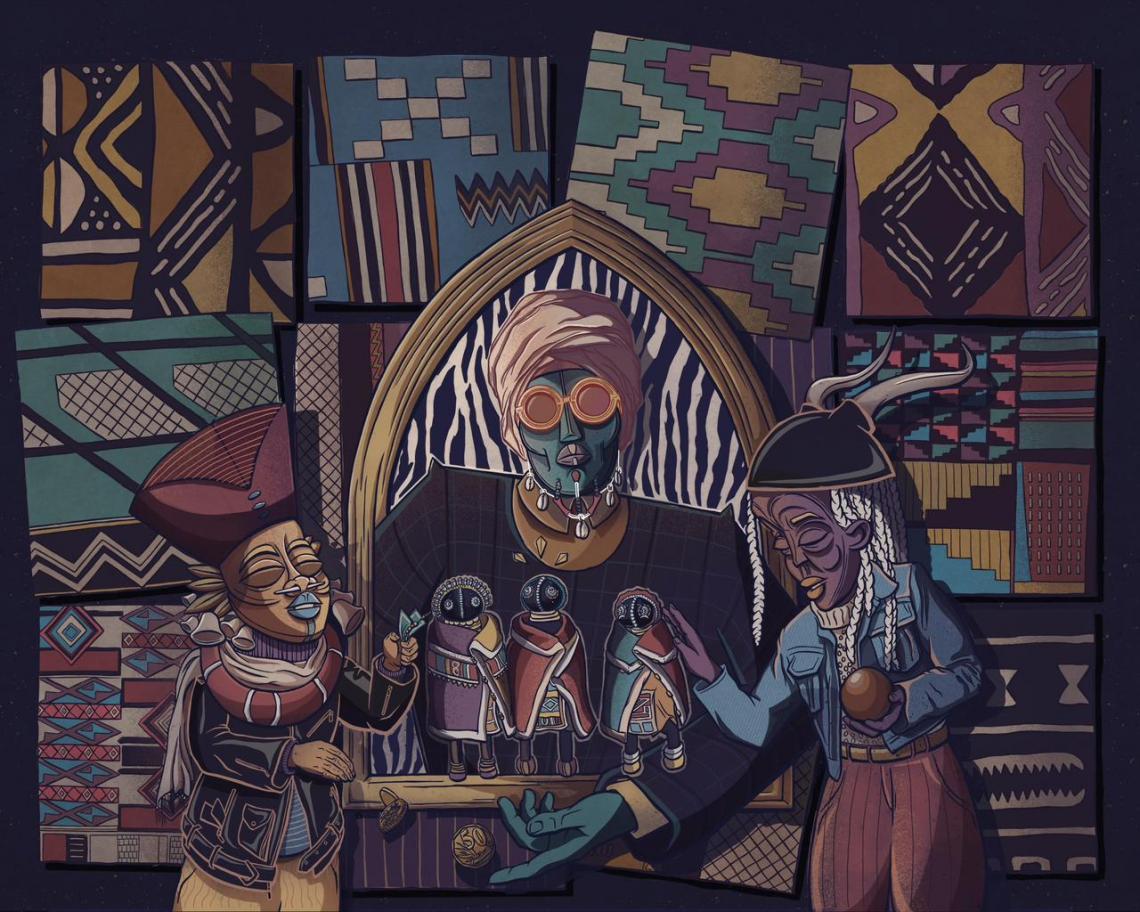
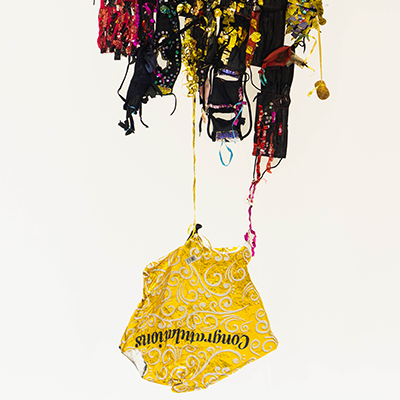
Annemi Conradie-Chetty
Wake (super spreader) 2020-2023
Mixed media tapestry
See more
Annemi Conradie-Chetty
With the outbreak of the COVID-19 pandemic and announcement of a state of disaster in March 2020, it became mandatory for all South Africans to wear masks in public. Discarded, used masks soon littered the streets and fields in and around my local town. The two works, Wave and Wake (super spreader), mark one person’s attempt to make sense of the impact of the pandemic by working with its debris: discarded, used medical masks. Each mask carries traces and stories: smudges of the make-up worn by the mask’s wearer, grime from the street, sprigs of grass from the field where it fell or blew. Since mid-2020, I have been collecting masks that I found walking around town, and - adding my own used masks - started sewing these together using blanket stitch. While I sanitised the masks, they still dirtied my hands. The twine that I used for sewing – also found on the streets – did the same. The work Wake (super spreader) followed in 2021, and was inspired by the first in-person weddings, funerals and graduation celebrations that were allowed following hard lockdown. Although we were excited to see friends, and relieved that we could once more celebrate and mourn together, fear of infection was never absent from these events. Even then, in some instances, the events led to further illness and even death. The black masks are decorated with shiny confetti, balloons and ribbons collected on the university campus following the first post-lockdown graduation ceremonies.
The time-consuming stitching of the masks into quilt-like textiles forced me to literally get my hands dirty as I tried to make sense of the threat and the psychological consequences of COVID-19: the isolation, and the social and economic impact of lockdown as well as dire consequences such as illness and death. While the sections of stitched masks might resemble quilts, instead of suggesting comfort, they engender revulsion as the soiled patches evoke the highly infectious virus. Although COVID-19 regulations have been scrapped in South Africa and masks are no longer worn, many have not recovered from the devastation wrought by the pandemic. The works invite viewers to pause and reflect on their experiences of this harrowing period, and the stories that might be buried inside these masks.
.png)
Wake (super spreader).
2020-2023
Mixed media tapestry
.png)
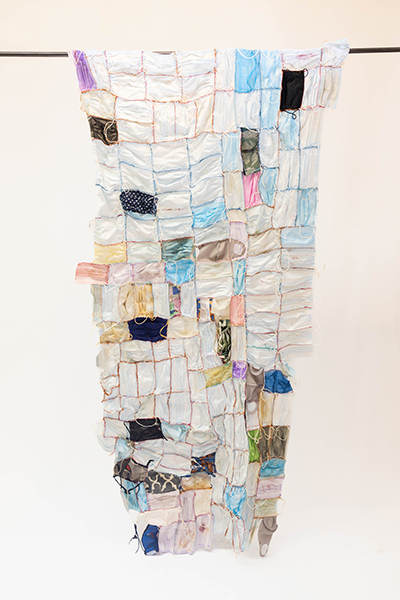
Wave
2020-2023
Mixed media quilt
.png)
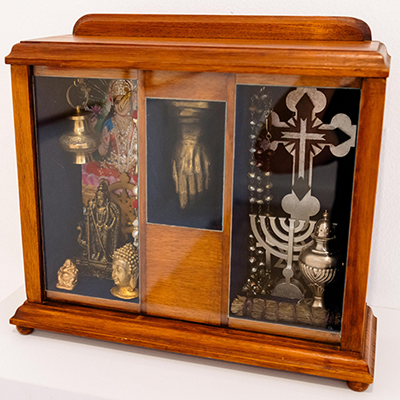
Candice Edwards
Stairway to Heaven 2023
Assemblage, 35cm x 31cm x 12cm
See more
Candice Edwards

I initially associated stairways with the Led Zeppelin song Stairway to Heaven, and the many stairways religion offers for salvation as well as the concept of heaven. I wanted to create an iconoclastic response of religious iconography, in part inspired by Neil Gaiman's American gods, that represents human spirituality and the ascension of the higher self.

Colette Lotz
Ruins, new beginnings 2023
Digital printed photography, 60cm diameter
See more
Colette Lotz
The series of digitally printed images, originating from cloud and structural photographs, serves as a contemporary exploration relating to the Rorschach inkblot tests, inviting viewers into a realm of introspection and interpretation. Each piece is crafted to evoke a sense of depth and ambiguity, reminiscent of the psychological complexities often associated with inkblot tests.
Central to the series is the thematic exploration of dualities and contrasts¬ - good versus evil, life versus death, heaven versus earth - manifested in the symmetrical compositions and evocative titles. "Ruins, New Beginnings" alludes to a scene where a turbulent landscape emerges from the remnants of destruction, with subtle imagery suggestive of hope and transformation.
The subsequent works - titled "Faith," "Power," "Contemplation," and "Peace"- further delve into the spiritual landscape, drawing inspiration from scripture and contemporary societal concerns. "Faith" embodies the essence of assurance and conviction, symbolised by subtle cross-like forms, prompting reflection on the intangible yet profound aspects of belief.
"Power" juxtaposes the tangible world of overhead electrical lines and urban infrastructure with the symbolic strength found in scripture, offering a poignant commentary on resilience amidst economic uncertainty. Meanwhile, "Contemplation" weaves together elements of the natural and man-made world, inviting viewers to meditate on the intersection of reality and perception.
In "Peace," the artist explores the elusive quest for tranquillity in a chaotic world, blending earthly and celestial imagery to create a liminal space of solace and introspection. Each work in the series serves as a catalyst for spiritual exploration, encouraging viewers to navigate the complexities of existence with renewed insight and understanding.



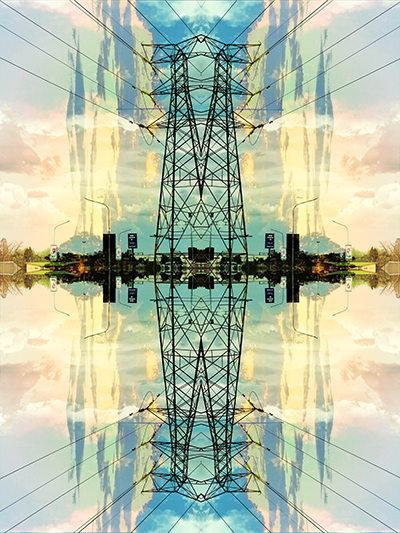
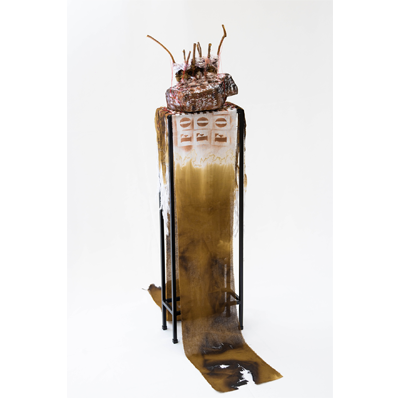
Corné Venter
Benediction: Sticks and Stones 2023
Mixed media, 130cm x 32cm x 12cm
Corné Venter
Benediction: sticks and stones library 2023
Mixed media: Jacaranda twigs, Sedimentary quartzite rock with enamel paint, cotton fabric dyed with potassium permanganate
The work, Benediction: sticks and stones library, grew alongside my fascination with and research into the geological makeup of the area I find myself living in at this point in my life. Sedimentary rock becomes metaphorical for sedimentary trauma. My body becomes a stencil reflected on the rock and temporal time itself is reflected as nothing when compared to the physical reality of this eons-olds piece of quartzite that is, was and will be – far beyond my puny life and efforts and any polemic that is current. The work includes a book with writing about the rock over cross writing over a discussion of a suicide attempt and has the word “NOTHING” cut out of the text with three figures of me with arms raised in symbolic Benediction crudely stitched onto the paper. The work further assumes the aspect of a pulpit or podium as the book, with its encaustic soaked cover, is suspended in the centre of a purpose-made stand which is covered by woven cotton hangings. These hangings were dyed using potassium permanganate (a powerful oxidant that is recommended as a disinfectant) which, in its turn, constantly erodes the fabric. On top of the podium and cloth is a quartzite rock that has been covered in graffiti that speaks to important dates and the contemplation of the rock as a signifier of nothing. Nothing in this case is opposed to the idea of something. It does not point to the absence of anything, but rather to the contemplative presence of nothing. Embedded in this rock is a row of jacaranda twigs (that “bleed” red thread), interwoven with a piece of fabric that repeats the phrase “FORGIVE TO FORGET FORGET TO FORGIVE”. This work becomes a heteroglossial conversation that the viewer might find difficult to decipher – a cacophony of screaming, crying, talking and stillness. Or, it might simply be a rock on a podium with torn fabric made by an obsessive and possibly delusional artist. This judgement I leave to the viewer.

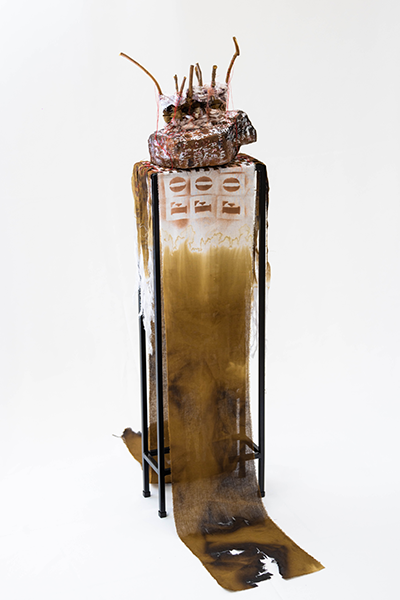
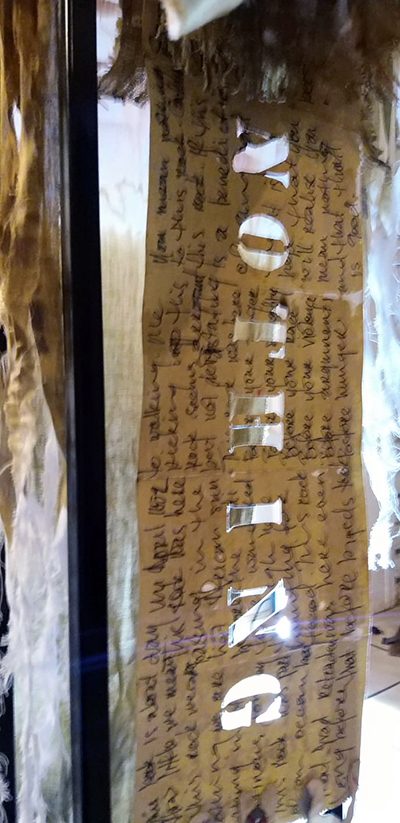
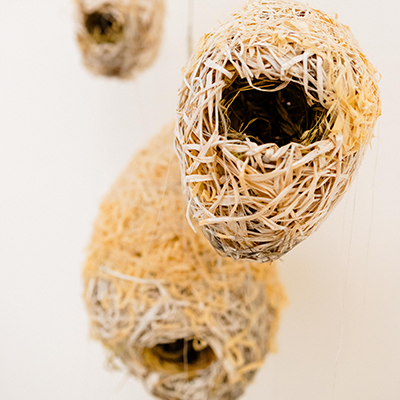
Danelle Heenop & Juan Steyn
The Core 2023
Mixed media / Sound installation, 41cm x 70cm x 30cm
Danelle Heenop & Juan Steyn
In nature, a nest is built, torn to pieces, rebuilt, and abandoned. It is a collective point of precious keepsakes or a stronghold on the point of collapse. The bird plays architect in a state of flux as it constructs a haven.
Through a laborious act of building five thematic nest clusters, we reflect on the nature of human identity using the nest as a metaphor for the phases of plunder, reconstruction, re-evaluation, and adaptations of our identity in an attempt to find a sense of belonging and security. The installations depict four main categories of belonging identified by Hiltunen et al. (2020: 11) that run parallel with factors influencing identity categorised as: (a) positive belonging, (b) searching for belonging, (c) struggling to belong and (d) scepticism towards belonging.
The last of the series confronts the viewer with an immersive experience.
These factors link with issues relating to family and core relationships, social media as a mask in the contexts of belonging, migration and immigrants, and global citizenship.
Mixed media is used throughout the series and includes both natural and man-made fibres. Sound installations embedded in the nests promote a thematic experience, creating an opportunity for reflection.
Reference
Hiltunen, K., Sääskilahti, N., Vallius, A., Pöyhönen, S., Jäntti, S., Saresma, T. 2020. Anchoring belonging through material practices in participatory arts-based research. Forum Qualitative Sozialforschung / Forum: Qualitative Social Research, 21(2): 11-22. https://doi.org/10.17169/fqs-21.2.3403 .
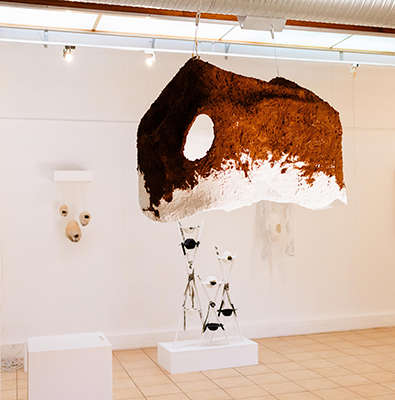
Contemplation, 2023
Digital printed photography
53cm x 63cm
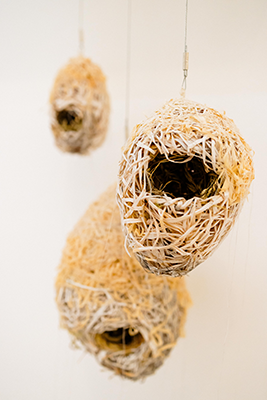
Faith, 2023
Digital printed photography
53cm x 63cm
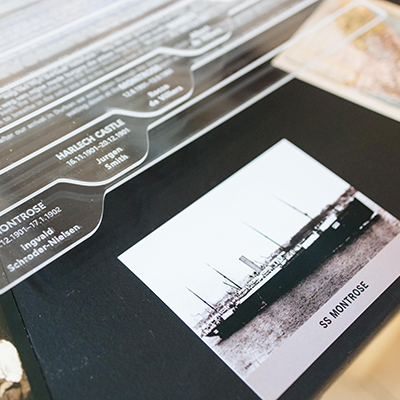
Franci Greyling, with Hennie Greyling and Adri Benade
Na Bermuda, 2023
Artist’s book: Multimedia
See more
Franci Greyling, with Hennie Greyling and Adri Benade
Na Bermuda
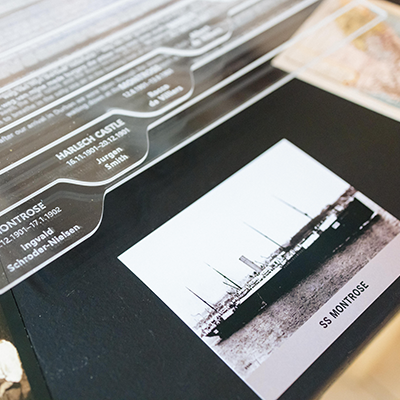
During the Anglo-Boer War of 1899-1902 (also known as the South African War), some 25 000 Boer prisoners of war and their sympathisers from around the world were sent to camps in India, Ceylon, St. Helena and Bermuda. The artist's book, Na Bermuda (the Afrikaans title means “To Bermuda”), captures the essence of the prisoners’ journey to the Bermuda islands in the western Atlantic and their attempts to record their experiences in writing. It serves both as an embodiment of vanishing memories and as a representation of times, events and people that have faded into obscurity. The artist's book provides an interactive experience for readers that resembles that of a researcher piecing together the past through archival materials. Furthermore, examining the artwork may elicit memories of family history related to the war or encourage reflection on the predicament of ordinary people who become entangled in warfare. Handicrafts made by prisoners of war inspired the format and execution of the work.

Héniel Fourie, with Armand Aucamp and Paula Stephanie Kruger
Toekoms Spoke (Future Ghosts), 2023
Film
See more
Héniel Fourie, with Armand Aucamp and Paula Stephanie Kruger
Toekoms Spoke (Future ghosts)
Film
2023
In the context of the last phases of the so-called Border War in South Africa in the 1980s, Toekoms Spoke expresses the memory and anticipation of a conscripted young man, on the train on his way to joining the army.
In a format similar to a classic three-act play, this project explores the notion of subjective time through a video triptych that expresses memory, attention and anticipation through montage. Montage creates a sense of conflated time through a linear unpacking. The first chapter (chapter one) explores the past through memory and possibly a recollecting dream. Chapter two concerns the present, which is expressed as a conflated instance in time influenced by the past and the future. Lastly, chapter three suggests a dream that anticipates possible future states.
This project explores subjective time in cinematography as the concepts of memory or recollection and anticipation or expectation, and links this to the concept of liminality in cinema. Memory and anticipation are aspects of subjective time that influence the present. The young man in the filmic montage waits on the train, remembering the time his father was conscripted. Through this recollection of the past and his current state (also conscripted now), he anticipates his future, all the while finding himself in a liminal state.
William Harmon (2000:291) defines liminality as a “state of being on a threshold in space or time”. In stories, the notion of liminality is salient when characters reflect (learning about themselves and their world), change or mentally grow. One might think of liminality using the analogy of the threshold; however, this description regards liminality as somehow static. Instead, as an illustration of liminality, Harmon (2000:291) offers the impression of the sea and seashore. The sea stretches from the shore into the distance, forming a barrier between land and sky. Thus, setting forth into the sea is to disappear eventually beyond the horizon.
In Toekoms Spoke, the train (both the journey and the cabin) constitutes such a liminal threshold; it could be seen as a lieu de mémoire (Pierre Nora’s [1989] term) and also a time-space of transition and uncertainty.
Credits: Toekoms Spoke
Written, directed and produced by Héniel Fourie
Cinematography by Armand Aucamp
Art direction by Paula Kruger
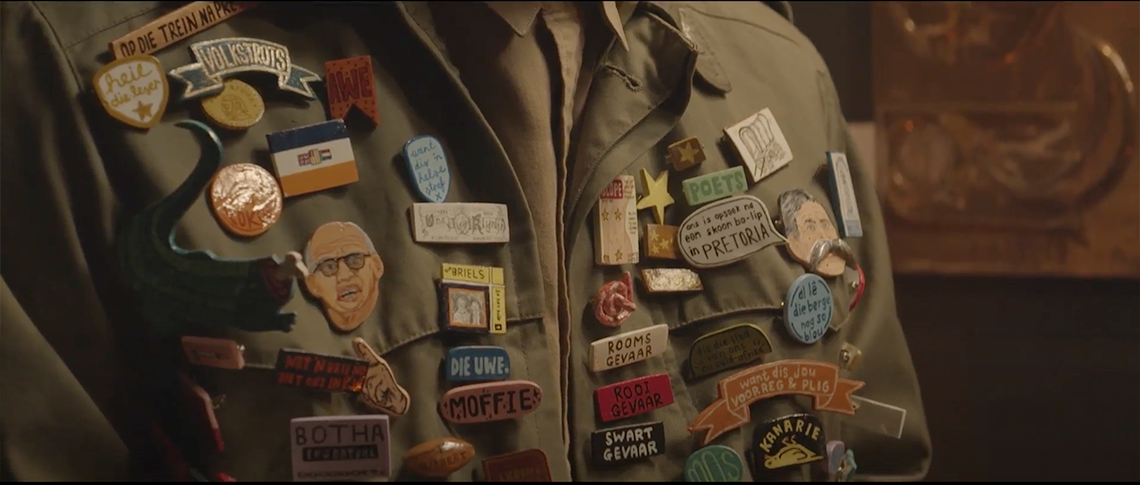
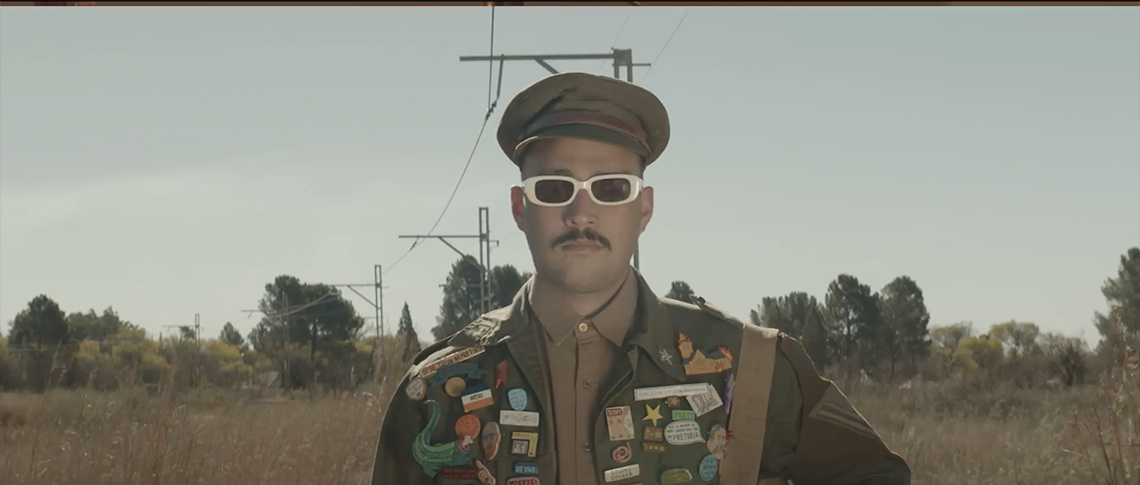

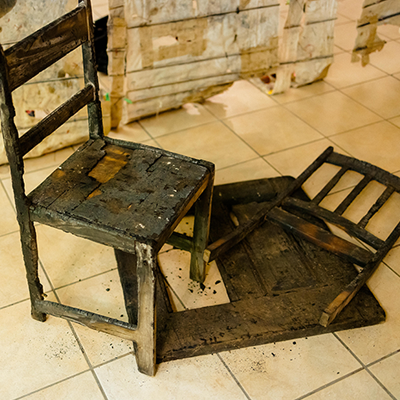
Jan van der Merwe
Speelgrond/Playground, 2023
Mixed media installation: Discarded toys and canvas, junk material and burnt objects
See more
Jan van der Merwe
Speelgrond/Playground
This installation, Speelgrond/Playground, incorporates found objects, images and junk materials that have been discarded. The work suggests loss and power abuse during times of upheaval - wars and disasters. I work with artefacts of our time and try to transform them into archaeological relics revealing human pathos and weakness. I try to create a poetic moment - an opportunity for reflection.
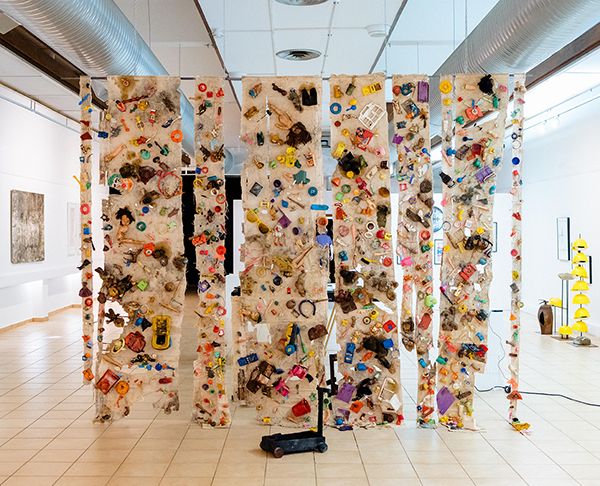
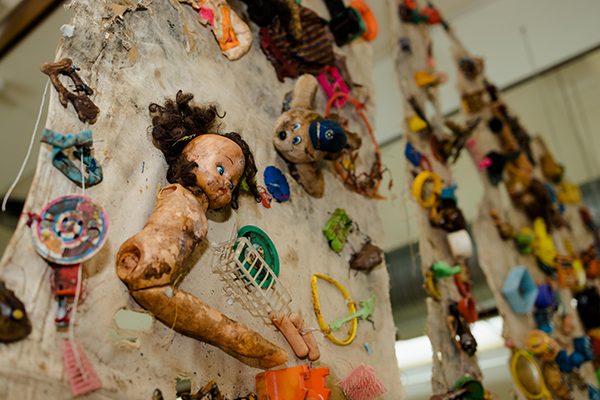
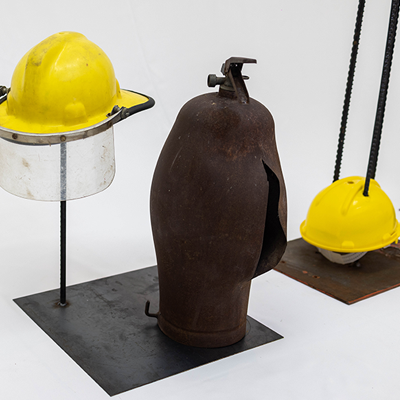
Jean Lampen
Crisis Control
Installation. Stone, steel, safety helmets.
See more
Jean Lampen
Blyvooruitzight 1, 2 and 3
Drawings: pen and watercolour
Up
Down
Installations: stone, steel, safety helmets
Crisis control
Installation. Safety helmet, fire extinguisher
All works 2023
As an artist, I am fascinated by the theme of Stairways and ruins. To me, it represents a connection to the past, a journey through time, as well as the resilience of the human spirit. This body of work focuses on abandoned gold mine shafts in the North-West and Gauteng provinces of South Africa, and the grand stairways that lead deep into the earth. As I was born and grew up as a miner’s daughter, the mining industry played a significant role in my personal history, as it did in the country’s. Abandoned mineshafts serve as a reminder of both great wealth that was extracted from the earth, but also the many lives that were lost in the pursuit of that wealth.
I hope that my work encourages viewers to reflect on the complexities of human society and the impact we have on the world around us.
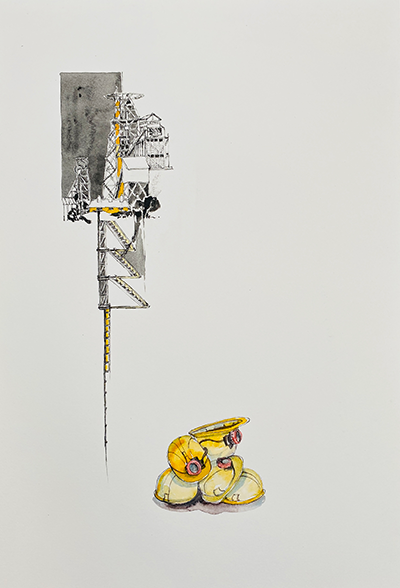
Blyvooruitzight 1
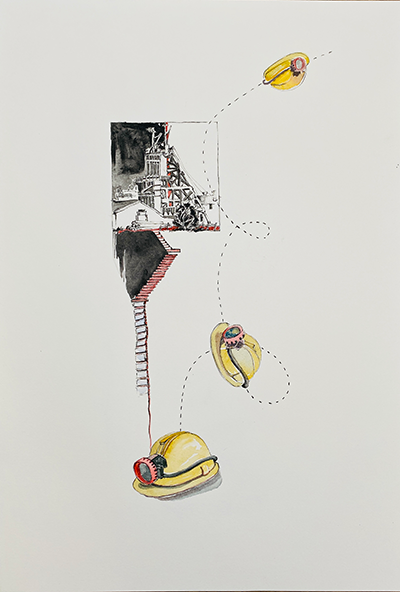
Blyvooruitzight 2
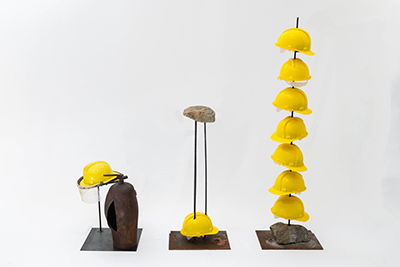
Up
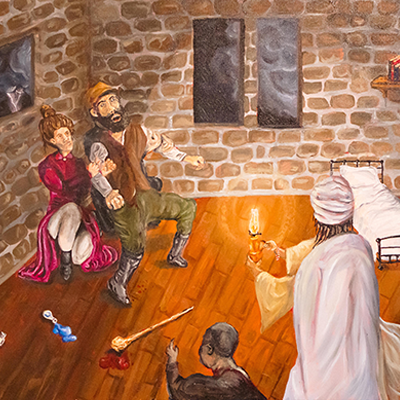
Joe Turpin
Sorrow Fountain (The Murder of Louis Tumpowsky)
See more
Joe Turpin
Sorrow Fountain (The Murder of Louis Tumpowsky)
Oil on canvas and mixed media
2023
Louis Tumpowsky was a Jewish man murdered in the North-West province in South Africa by Dorethea van der Merwe in 1918, who was tried in Potchefstroom and hung in Pretoria, becoming the first white woman in history to be executed by the South African state. It is a story of love, affairs, poison, a sangoma, deceit and complex racial relations, but also forms part of my upcoming and continued research of Jewish history in the North-West province.
The oil painting depicts, in dramatic fashion, lighting and style, the murder taking place.
As a Jewish man based in Johannesburg, I identify with, or see some ancestral links, with Tumpowsky. The work is sympathetic to him, but does not attempt to demonize anybody else. Van der Merwe’s accomplices were coaxed into aiding her and complicity. The painting connects with the ruins side of the theme, Stairways and Ruins, more specifically with memory, remembrance and memorialisation (of Tumpowsky as a person, but also of Jewish South African history), folklore, myth and legend because even though this was a real history, Van der Merwe’s motives and methods involving the supranatural and use of magic, which she never denied, have become topics of legend, as well as then fact and fiction, autobiography, biography, in the telling of a true historical event.
As a multidisciplinary artist from Johannesburg, South Africa, I use archival research to locate narratives, allegories and semiotic pointers that are charged and informed by historical events or mythologies. These fables influence my current focus on paintings and mixed media installations. I question how these narratives that reflect the past and present also resonate within a wider social context, initiating forms of activism that bring people together.

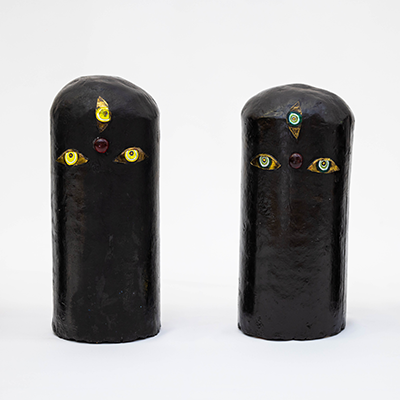
Kaylin Moonsamy
Relic I, II, III, IV, V VI, VII
See more
Kaylin Moonsamy

Relic I, II, III, IV, V VI, VII
All brass, glass and oil on clay
All 2022
All 13,8 diameter, freestanding
The works represent an ancient spiritual school of thought, found in many cultures, that uses the physical to access the spiritual. To move from the gross to the spiritual is the essence of the series. The work explores the concept of one's energy rising to a divine possibility, thereby altering one's perception. It is a metaphoric stairway to the spiritual as suggested by Bessie Head.
It is believed that energy rises up the spine through seven energy centres or chakras of the body during meditation and prayer. The chakras are located at various points of the body. It is believed that once energy reaches the furrow of the brow, a heightened sense of perception, known as the third eye, becomes accessible, evident in the works. Some components of each sculpture were painted in colours associated with the chakras.
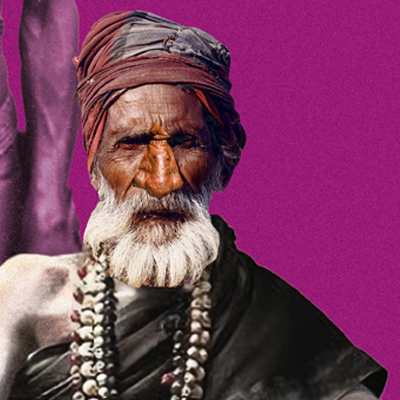
Kiveshan Thumbiran
Hanuman, Ashwattama, Parshuram
See more
Kiveshan Thumbiran
Hanuman
Ashwattama
Parshuram
All 2023
All digital prints on Epson advanced archival paper
The notion of ruins appealed to me. Since my work makes use of Hindu mythology and an Orientalist and structuralist mythological framework, I tend to focus on the idea of mythology as a means for interpreting the Western world. I wanted my work to focus on the notion of ‘living ruins’ which is embodied by the Chiranjeevis, the seven immortals, in Hinduism. Of these seven Chiranjeevis, I have chosen three figures whom I felt embodied the exhibition’s theme. The first is Parshuram (a man believed to be an incarnation of the deity Vishnu). Parshuram was born to the Brahmin (priest/ascetic) caste; however, he took up arms and fought against the Kshatriyas (warrior caste) when they began to use their power against those whom they were charged with protecting. He is also an immortal charged with waiting for Kalki, another form of Vishnu who will destroy the Earth when the time comes. My depiction of Parshuram focuses on Parshuram and Kalki. In my work, Kalki is born as a Zulu warrior, playing on the idea that if all life originated from Africa, it should end here as well.
Secondly, there is Hanuman, a deity who is believed to be an incarnation of the god Shiva. He was born among the ape-man race to help Lord Rama restore balance. Hanuman is said to have swallowed the sun as a child. Only after the gods bowed to him, he let it go. As a gift for doing so, he was granted immortality and charged by Lord Rama to guide humanity on the path of righteousness. In my work, his depiction moves away from his usual wrestler appearance towards that of a wandering hermit or fakir who only seeks bhav (devotion).
As depicted in my work, the figure Ashwatthama becomes a tragic immortal. He was a great warrior, blessed with a magical gem in his head, which made him immortal, and allowed him to overcome hunger, age and illness. He participated in the greatest war in Hindu mythology known as the Mahabharat. After the war, Ashwatthama attempted to murder an unborn baby. The child was saved by Lord Krishna who, as a punishment, had Ashwattama’s gem removed, which left a giant rotting hole in his forehead. In my work, I explore his character as a bitter old man who is taunted by the whimsical Krishna.
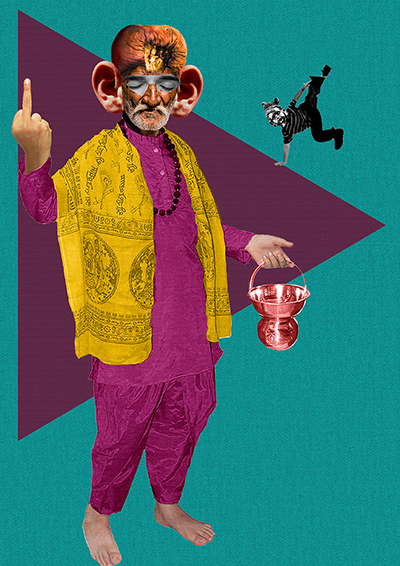
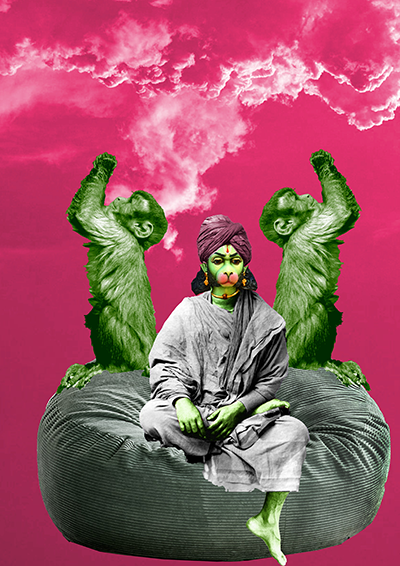
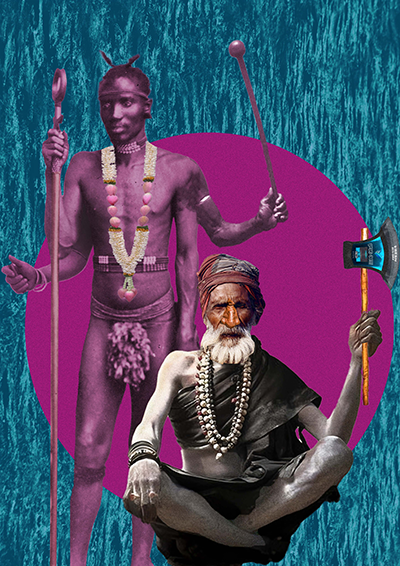
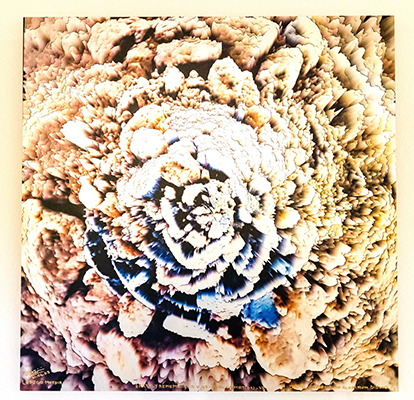
Lesego Motsiri and Pieter Odendaal
Earthly Remembrance (I-V)
See more
Lesego Motsiri & Pieter Odendaal

Lesego Motsiri (digital prints - digital drawing on aluminium dibond)
Pieter Odendaal (original poem)
Earthly Remembrance (I-V)
2023
Earthly Remembrance is a collaborative work that explores themes of (un)belonging through the mediums of poetry and digital prints. Odendaal’s poem “bainsvlei, mangaung” (below) explores legacies of land appropriation and relationships to soil in the context of a post-apartheid poet who deals with his ancestors’ actions. This poem served as inspiration for the creation of five digital prints by Lesego Motsiri, based on photographs taken at various graveyards in Mangaung. The prints hint at explosions, disorientation and imbalance, but also at regrowth, thereby mirroring the theme of the poem. The works are linked to the Artivive app, thereby offering the viewer an immersive AR-experience of the work. Each of the prints were animated on the Artivive app and includes audio of Odendaal reciting excerpts from the poem. The work offers Odendaal a way to process the legacy related to the soil of his forefathers, and the collaboration with Motsiri adds further layers to the work, incorporating perspectives from a descendent of those who were previously oppressed. Earthly Remembrance speaks to the exhibition’s themes of memory, revision and restitution, as well as reimagined pasts.
Original poem:
bainsvlei, mangaung
Pieter Odendaal

Lindi Cameron
DVR & NVR
See more
Lindi Cameron
DVR & NVR
Mixed media: Weaving, mixed media. Printed photo collage, fabric, thread
DVR and NVR are homages to my late parents, with DVR - my mother, Daphne van Rensburg, having lived 74 years (she passed in 2019), and NVR representing my father, Nordin van Rensburg, who died at 78 years old (in 2022).
Civilisation has engaged in rituals surrounding death over centuries, often using art and textiles in depicting stories or for preparation of the afterlife. As a homage to my late parents, I wove two stairways “to the stars” with things left behind - memorabilia, documents and photographs - in a tapestry timeline of sorts, allowing more storytelling of the ‘dash’ between birth- and death dates.
In mythology, weaving is associated with control over mortal lives, as well as with destiny, via the goddess Dalia of Lithuania, and the Three Fates of Greece. Clotho, the spinner, created a web of life, Lachesis measured its length, and Atropos cut it. Through the process of weaving, I could revisit memories and meditate on priorities and legacies while examining some of the material things left behind. While cutting the textile from the loom symbolises an ending, it also represents rebirth and renewal, as an object is created in the process. This becomes a metaphor for the earthly end of life, and the spiritual afterlife.
As in the mythological Greek Fates and Lithuanian goddess Dalia’s control over mortal lives, thread represents the web of life, its length and end. Gold harkens Japanese Kintsugi, embracing life’s cracks or imperfections. Checkerboard blocks are inspired by the game of snakes and ladders, as well as pixels making up a whole.
The main symbol for DVR means "between birth and death is life", and the main one on NVR relates "the soul's journey through life". The works share symbols meaning "family of four: man, wife, two children", the square with crosses in it that represents a year, and “suffering” from illness. Age-old universal symbols are used that denote gender, astrological signs, suffering, faith, time, and eternity. We are all unique, yet share similar experiences, and form part of the community fabric.
Clare Harner’s poem , “Do not stand at my grave and weep”, was split into two, with lines assigned to DVR and NVR. Additional imagery is used to evoke the sense of transcendence into the skies and ripened fields.
These lives were triumphant and ultimately transcended earthly death. We are left with roots, wings, memories, lessons, heritage and values, long after sorrow subsides.
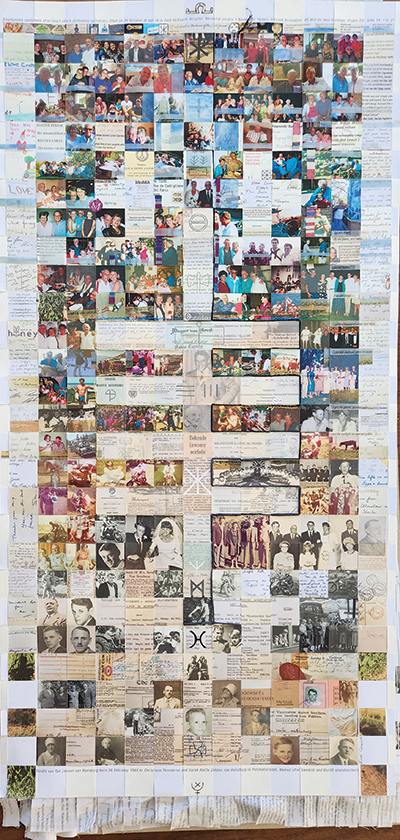
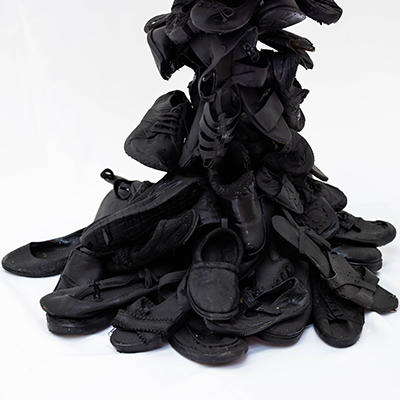
Louisemarié Combrink
War dreams
See more
Louisemarié Combrink
War dreams
2023
Approximately 60cm x 60cm x 180cm (height)
Shoes, books, toys covered with resin and paint
War dreams is a conceptual contemplation on the fragments of lives and hopes in the face of war. Shoes, books and toys dot mountains of rubble and ruins in post-apocalyptic scenes following missile strikes. Such images sparked the content and appearance of the work. Reminiscent of Holocaust images of heaps of shoes signifying horror and absence, War dreams uses shoes as symbols of death and loss. Shoes suggest the physical bodies of their wearers, and also their absence, and the soil in which life and toil happened. In the work, a flutter of books makes up the top half of the sculpture to create a totem-like appearance. Books remind us that we are storied beings, and are the repositories of our heritage, culture and history. War dreams alludes to the destruction of libraries, personal book collections and with this, the loss of stories and memories. The books in the work are stalled in time, having become illegible yet expressive of the anguish of such loss. The toys that are visible in sections of the work remind us of the plight of the most vulnerable, and war’s indiscriminate massacre of the innocents.
What do we dream of during times of war? Perhaps consciousness yields to broken images, stony rubbish, lost lives, and fills our dreams thus. Perhaps there are tiny glimmers of hope, as the books that take flight at the top of the sculpture suggest.
The sculpture is accompanied by a QR code that allows the viewer to listen to a recording of the poem To my daughter, a poem by the Ukrainian soldier and poet Pavlo Vyshibaba – from the front lines of the battlefield. In the recording, the Ukrainian is followed after each line with the English translation. The voices of Ukrainians residing in my neighbourhood were used (Dariya Sushch and Anton Dmytriiev). It is a war poem about beauty and life, refusing to see only horror and darkness – instead musing about cherry trees, apricot blooms and the songs of grasshoppers in the land of war refugees.
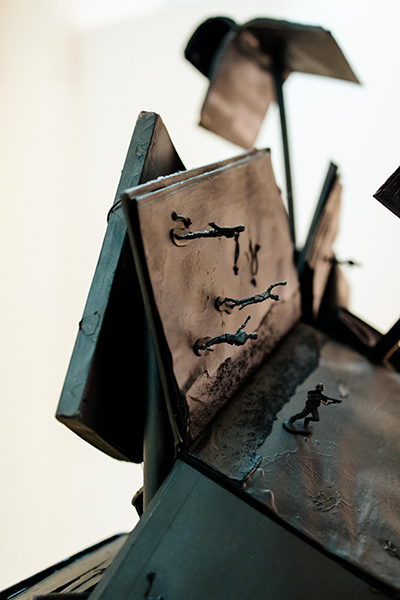

Marina Herbst
Recall 1, Recall 2
See more
Marina Herbst
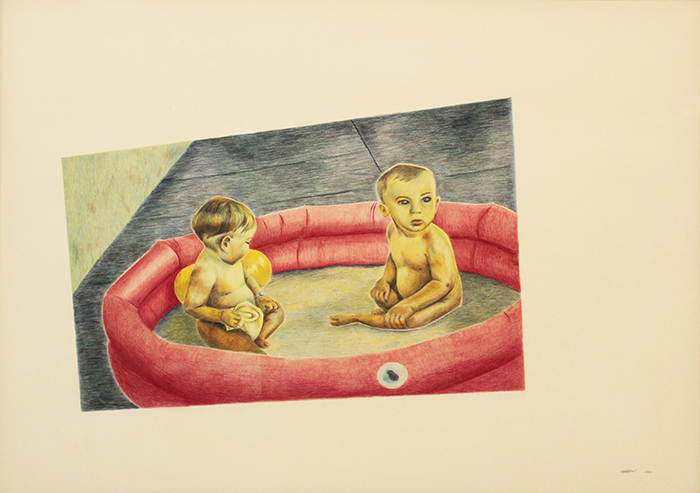
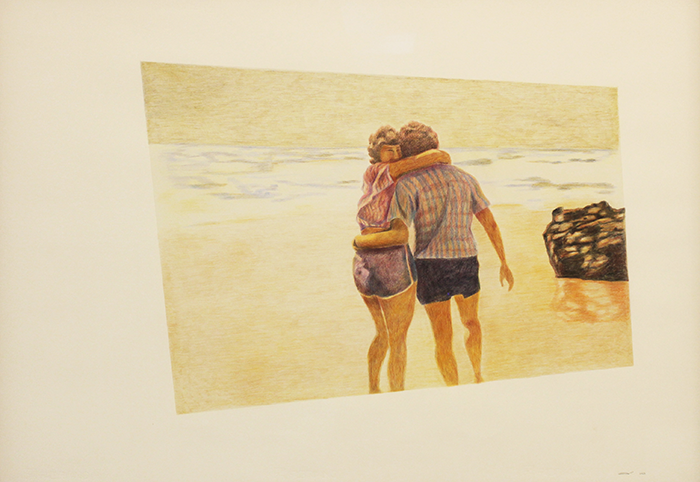
Recall 1
Recall 2
Drawings; coloured pencil on paper
The intimate debris of people who came before us are powerful connections to our own perceptions of who we are, or who we think we ought to be. We carry with us precious artefacts, stories and behaviours that express a glimpse into their lives and also their silenced narratives, and often we imagine these as being different from our own reality. The work is an attempt to relive the vivid intimacy of the lives of my ancestors as if it were part my own. The loss of innocence, post-memory, liminality, belonging, and the layering of past and present are addressed to explore the fragility of memories that connect us to our identity in the onslaught of impersonal, trend-driven, and often one-sided public narratives.
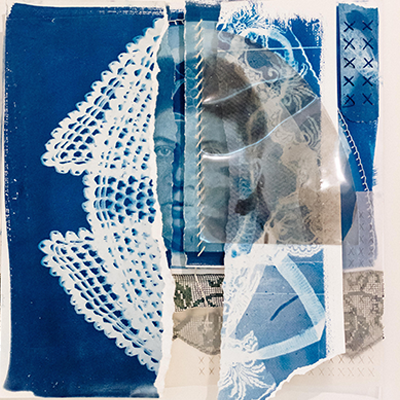
Marna de Wet
Threads, Entwined 1, Entwined 2, Fragments
See more
Marna de Wet

Threads, Entwined 1, Entwined 2, Fragments
Cyanotype prints with cotton thread on paper
As an artist, I am drawn to the interplay between the past and the present, and the way in which objects and images can serve as conduits for memory and history. For example, there is the memory of my father telling me stories of my great-grandmother, MCF Kriek, and her three children in the Balmoral concentration camp during the South African War of 1899 to 1902.
Cyanotype is a wonderful medium to merge objects and images. I set out making new photographic prints using lace and shed snakeskin together with an old photograph of my great-grandmother, all of which are materials that represent both fragility and strength.
The theme of Stairways and ruins serves as a metaphor for the way in which our memories and histories are often fragmented and incomplete. By layering different elements and textures onto the photographic image before it is exposed to light, to complete the cyanotype process, I sought to create a sense of depth and complexity, as if the images are emerging from the depths of the past.
Lace represents the delicacy and beauty of the past, while snakeskin represents the shedding of old identities and the process of transformation and growth. The cross stitches represent the 426 people who died in the concentration camp at Balmoral. Together, these materials evoke a sense of nostalgia and melancholy, while also suggesting the possibility of renewal and rebirth.
Through my work, I aim to create a dialogue between the past and the present, and to explore the way in which our personal histories shape our understanding of the world around us. The works invite the viewer to reflect on their own relationship to memory and the way in which the past continues to resonate in the present.
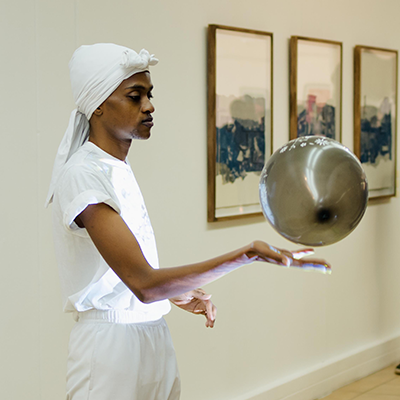
Neo Diseko
Waiting to exhale
See more
Neo Diseko
.png)
.png)
Waiting to exhale
2023
Video and performance
Inspired by the deteriorating condition of the Juskei River; Alexandra, the work, Waiting to exhale, addresses the complexities of identity and belonging through folkloric alterations of water as a metaphor for healing, spirituality and belonging.
The video can be watched here: Neo Diseko waiting to exhale
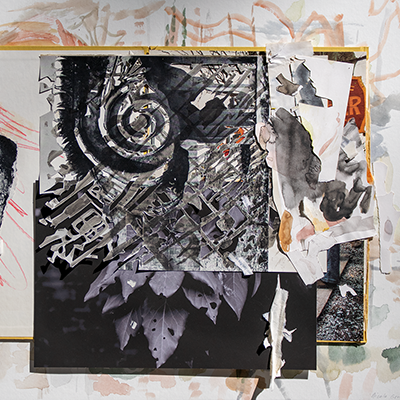
Nicola Grobler
Multispecies records: Leafcutter, Leaf-eaters and Cut through chronicles
See more
Nicola Grobler
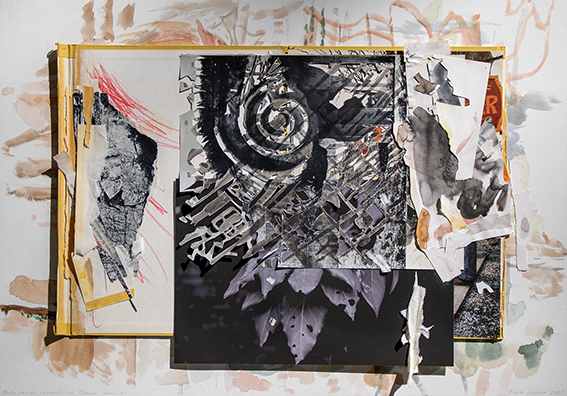
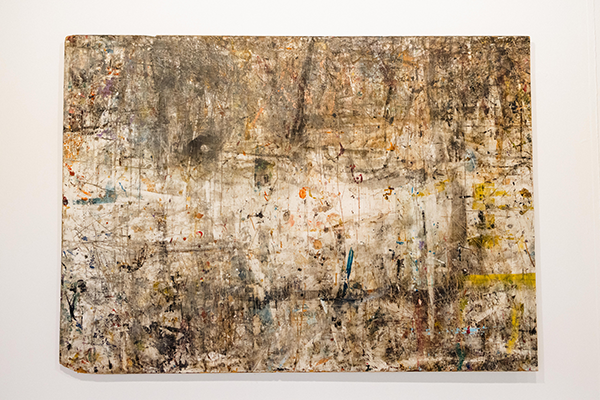
Multispecies records: Leafcutter, Leaf-eaters and Cut through chronicles (2023)
I explore the theme of Stairways and Ruins through the notion of multispecies archives. In Multispecies records, the collage methods of cutting, layering and fragmentation/synthesis are used to explore ideas of simultaneity, collaboration and co-existences in relation to historical records. Through layering and combining, the method of collage allows for overlapping time-space relations that can challenge anthropocentric, monolithic accounts of history. Fragments of multispecies stories, historical records and gestural marks are combined and reconstituted in the present moment anew. By intersecting images and ideas, collage acts as a stairway towards nonconformist readings of reimagined pasts and futures. Cutting provides access to surfaces beneath layers and forces a perspective through multiple layers; these textured surfaces could suggest the complexity and multiplicity of natural-cultural environments.
These works intend to hold a space open for reflections on more than human collaborators and the consequences of their interactions. Simultaneously, my process of cutting imposes grids and thus splits uniformed surfaces into isolated fragments. Torn fragments are suggestive of ruins, of imperfect worlds.
The large-scale work Consequences and reactions presents a found object, a worked surface from the University of Pretoria’s printmaking studio. Years of cutting, inking up and mess have coalesced into an evocative collaborative artwork. Over an extent of roughly 30 years, students have worked over these surfaces, creating unintended gestures and the resultant, accidental object proposes a lively and affective space of making. In response, I am seeking to connect to the dissipated energy of printmaking processes, and the changing circumstances of making and makers in South African art institutions. The found object functions as a connective or mediating device while these residues of creative work are captivating.

Paula Stephanie Kruger
Want dis jou voorreg en jou plig - ‘n zef afrikaner boere girl
See more
Paula Stephanie Kruger
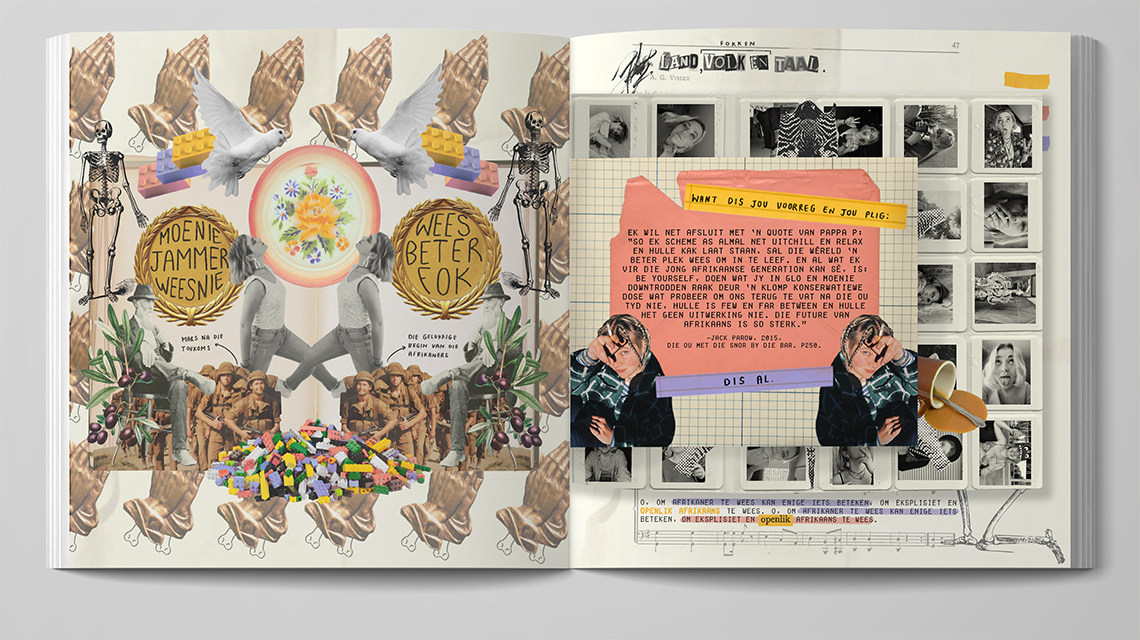
want dis jou voorreg en jou plig- ‘n zef afrikaner boere girl (because it’s your privilege and your duty: a zef afrikaner boer girl)
Medium: paper(zine)
Dimensions: 210mm x 210mm
want dis jou voorreg en jou plig, ‘n zef afrikaner boere girl is an auto-ethnographic zine about how an identity crisis is formed between two cultures. The project consists of a 58 page zine of 210mm x210mm, and has an interactive aspect: people can use their phones to scan a QR code to gain access to material.
In many ways, my childhood years were dominated by Afrikaner nationalism, presented as a ‘gift from God’. During my adolescent years, I began to experience external influences through music broadcast by MK television, which caused an identity crisis for me - because I was taught to be ‘all for Jesus’ but in certain aspects of my life I began to drift towards the alternative Zef culture.
Paul Ricoeur's narrative identity theory proposes that identity consists of two parts - idem identity (one's physical existence) and ipse identity (human agency, including our beliefs and actions). The stories we tell and are told about us connect these two parts and help to explain the contradictions between the two. My idem identity is largely aligned with the Zef culture through my clothing and style, which I was taught at a young age that women should not wear. I do not adhere to the ethics that women should follow when it comes to my personal hairstyles. My crude and crass language reflects a more liberal outlook and yet elements of my ipse identity are definitely more in line with the Afrikaner nationalist beliefs that I was taught as a child. Some of my values are more conservative - that is, church-oriented, family-oriented, the appreciation for Afrikaner history and pride in Afrikaans as a language. Through my stories, my idem and ipse identities merge and form my personal narrative identity. The tension in my identity crisis exists because there are aspects of both identities that I disagree with. The conflict between my personal identity and my cultural and social 'tags' occurs in how I physically belong to a certain group, while in certain aspects my values do not.
My work is related to the theme of Stairways and Ruins in that I have created a new path to my own future by taking the past (ruins) and turning them into a stairway to a place where I create my own narrative in my own identity, and in a way, creating a stairway to my future.

Ricardo Luit
Linger series
See more
Ricardo Luit

Through this triptych series, Linger, I delve into the profound concept of the constancy of energy in the universe—an enduring force that undergoes transformation rather than destruction. This scientific truth, which has fascinated and perplexed researchers for generations, serves as the foundation for my artistic exploration. Utilising a combination of photography and digital manipulation on cotton paper, I present three sun-exposed prints that capture the interplay between memory and time. Through digitally manipulating photographs, I aim to convey the lingering echoes of our past experiences and actions, weaving together a visual narrative that speaks to the interconnectedness of our existence.
Guided by the exhibition's theme of Stairways and Ruins, my artwork delves into the notion that our actions imprint upon the environment, manifesting as haunting apparitions that shape and influence it. By documenting my immediate surroundings, I uncover specific instances of human impact—waste, overconsumption, and neglect—serving as poignant reminders of our collective influence on our environment.
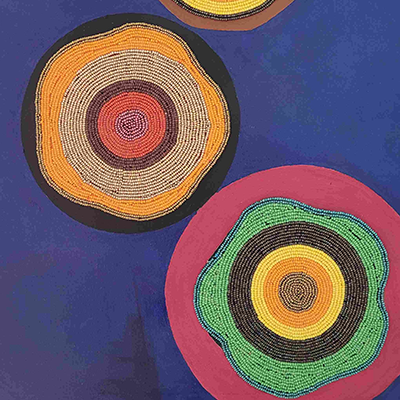
Sandile Basi
Inner circles
See more
Sandile Basi

Inner circles
2023
Oil paint and beads on canvas
The painting, Inner Circles, is from the series Vukuzenzele, featuring mixed media works that bring together brightly coloured beading, organic patterns and geometric shapes on backdrops of flat colour.
In this painting, the various dimensions of life are explored through beaded circles that symbolise circles of time. The concentric rows of beads sparkle and mesmerise the eyes, reminding of brightly coloured growth rings in trees, marking cycles and seasons. Time is not represented as linear, but rather as circular, and beginnings and endings are difficult to define. For the artist, the inner circles simultaneously depict what has been and what is. While the past and present moments differ, they also share similarities.
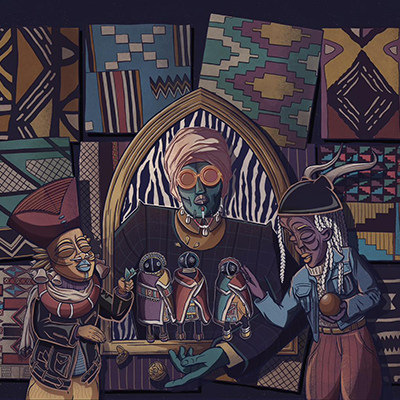
Zhi Zulu (Zinhle Zulu)
Market-face
See more
Zhi Zulu (Zinhle Zulu)
Market-face
2023
Digital illustration print, framed with integrated monotype prints
420mmX 594mm (A2 landscape)
Market-face is a social commentary on the African economy and the way we are portrayed to tourists.
We find ourselves 28 years into the post-Apartheid era where South Africa is the go-to cosmopolitan place. While the image of Africa (as it is portrayed to the world) slowly changes and is demystified by the internet, many forms of cultural representation are something I still find interesting.
Souvenir shops are especially fascinating because of this. These shops are often riddled with items that give a concise and affordable means of cultural representation, and sometimes reduction. The seller may not necessarily know the symbols and origins that have perhaps been washed away or reduced by centuries of forced cultural ruin. Although the history is preserved through the spoken tradition, we start to see a disconnect between the records and origins while the symbolic forms of African history are being traded for money. It portrays a fine line between the celebration of cultural pride and the commodification of sacred symbols to be appropriated at an affordable price.
The artwork also draws on the metaphorical strings of the masks- we don’t know who’s who. The consumers could be the tourists themselves or it could be us as Africans, scavenging for a way to compensate for the lack of knowledge we may have about our ancient traditions and how they’ve been symbolised. The Zulu angels are pivotal to the message of the artwork. This is representative of the fact that of all the things that have been ripped away from Africans, the biggest robbery has been that of the knowledge of our spiritual origins.
Despite this, we celebrate what we can and find a way to put on a happy face, even if it is a mask, and we frame it as our only way of celebrating our culture. Our culture has become a hustle, and we take what we can get.
